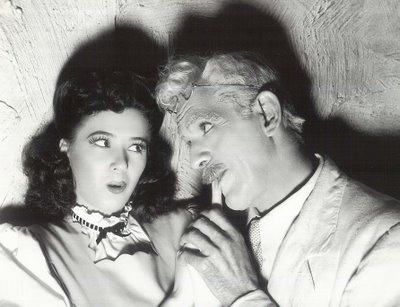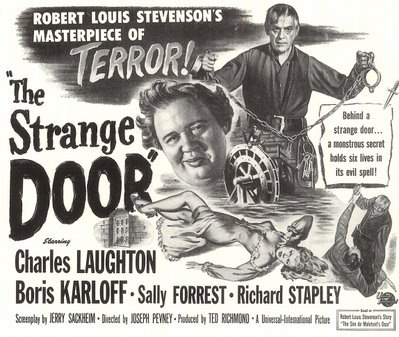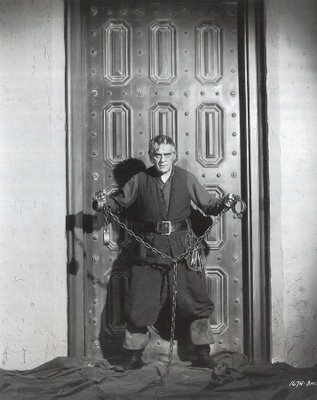
Boris Karloff --- Part Two

Slide whistles in the main title theme of a Boris Karloff vehicle would seem neither welcome nor appropriate, but that’s just the opening bell for 66 minutes of derivative slap-stick-ery inspired by the success of Broadway’s Arsenic and Old Lace. The Boogie Man Will Get You was in theatres by October 1942, long before Warners could release its screen adaptation of the Karloff stage smash, allowing this pallid facsimile to give provincial audiences a taste of what they’d been reading about in Life and The Saturday Evening Post. Arsenic was black comedy of a sort new to movies, and Boogie Man treaded a ridge between harmless plagiarism and outright, actionable theft. This time Karloff’s misunderstood scientist was played for laughs, only here the yoks are few, so often the case when we’re force-fed zany antics by players straining too hard for the effect. Bodies are piling up in Karloff’s basement, but I had a feeling none of them were really dead, for if they were, he’d soon enough be facing the same electric chair that claimed him in previous Columbia outings. Sure enough, the "corpses" march unceremoniously through his lab just before the fade, arriving as if on cue to checkmate possible Code intervention. Karloff had a deft hand for comedy, and his parlays with Peter Lorre anticipate future teamings on Route 66 and AIP’s The Comedy Of Terrors, itself a similarly labored exercise in dark humor. The great thing about Arsenic and Old Lace (pictured below is a still from the Broadway production) was the prestige it conferred upon Karloff at a time when his career really needed a jolt. A "B" level comedy/horror for Columbia was tangible expression of the actor’s new status, but the truer reward by far was conferred by Universal two years later when they combined Technicolor with a big-budget musical thriller starring Boris Karloff …


The Climax is Universal-ly reviled by fans of Karloff, but when was any horror headliner otherwise entrusted with Technicolor amidst "A" trappings? The previous year’s Phantom Of the Opera was thought too lofty for the likes of Chaney, Jr., despite his familial links with the role and contract availability. Were it not for Arsenic and Old Lace, I doubt very much if Karloff would have gotten The Climax, even if Universal did play games with his billing (first position in the credits, but second to Susanna Foster in the trailer). I like this show because Karloff is at all times elegant and commanding. He’s also striking in Technicolor, enjoying plush accommodations denied him at Columbia and in lesser Universals. Horror fandom seldom overlaps with an appreciation for Susanna Foster, so I can understand the antipathy viewers feel toward The Climax. Universal would easily score bookings for a lavish follow-up to Phantom Of The Opera in theatres that wouldn’t dream of playing The Boogie Man Will Get You. Cheap horror movies were not for first-run houses. The Climax was sold as something quite different (and that's actress June Vincent with Karloff during an on-set break). Universal’s trailer emphasizes Karloff’s Arsenic antecedents. Romantic lead Turhan Bey, himself a veteran of previous horrors, is now celebrated as a romantic new star, acclaimed for his role in "Dragon Seed." The idea was to disassociate these players from low-budget monster movies, as premiere audiences of the day had no more interest in these than modern day Karloff fans have for Susanna Foster or Turhan Bey. With its emphasis on music, The Climax can’t help but disappoint horror mavens, but is it really any worse than the 1943 Phantom Of the Opera in that respect?



I don’t like seeing Karloff belittled and pushed around, least of all by the cut-rate likes of Stephen McNally, whose sole worthwhile accomplishment at the time of The Black Castle had been stealing Jim Stewart’s rifle in Winchester ’73 and engaging in some reasonably colorful villainy therein. Why diminish Karloff in these fifties costumed gothics? Was he regarded as too old to carry the lead? I wanted to see him play McNally’s part in The Black Castle. Imagine Boris with a patch over his eye, consigning victims to those same alligator pits McNally presides over so listlessly. And what twisted form of logic confers top billing and the leading role to past-his-prime Richard Greene? Watching The Black Castle was a bitter experience for this Karloff admirer. I’d glimpse him briefly fifteen minutes in, then he’d disappear for several reels. The role could have been played by Paul Cavanagh, Alan Napier (and both do lend minor support in The Strange Door), or any number of competent thesps. It’s obvious they only hired Karloff for his name, much as was the case with Bela Lugosi and Night Monster. There’s more effort toward selling Richard Greene as a swashbuckling romantic, Flynn-ed out in sword fights and tavern brawls. The Black Castle is no more a horror film than The Prince Who Was A Thief, The Golden Blade, or a dozen other Universal-International pageants, and I could as easily imagine Jeff Chandler or Rock Hudson playing this at about the same level of competence as Greene. As for Karloff, he was actually better served as Dr. Jekyll and (being doubled as) Mr. Hyde opposite Abbott and Costello.


Karloff doesn’t enter The Strange Door. He’s dragged in, thrown on the floor, and kicked by a top-billed Charles Laughton. Much of the film is taken up with the frustrated romance of two utterly vapid young players, Richard Stapley (once a Hal Wallis contract hopeful) and Sally Forrest (whose own billing was increased to equal prominence with Laughton and Karloff in a special pressbook supplement). Those tavern dust-ups so beloved of unimaginative Universal writers are given play in the opening reel of The Strange Door, and despite atmospheric graveyards and castle sets to come, we know horror themes will run a distant second to generic action-adventure content. Everyone seems committed to withholding Karloff’s presence. His is the mysterious eye peeking through walls for most of these 81 minutes, an impassive and largely offscreen observer of Charles Laughton’s flamboyant over-playing. The Strange Door was a step down for Laughton as well, though his motives were pure in that he wanted to finance his ongoing acting workshops and used fees from films like this (and Abbott and Costello Meet Captain Kidd) to do it. If uninhibited Laughton is your meat, here is a banquet of same. Would that Karloff have had such a rich histrionic opportunity! As it is, he’s the loyal, self-sacrificing family servant (always the weakest role in any cast), whose voluntary forfeitures on behalf of undeserving masters seem pointless and unmotivated. No man (or actor) at 64 should have to endure two gunshots, night swims across a moat (after being shot), and a literal backstabbing from one whose part he should have played. Karloff might have managed all this twenty years before, but seeing him attempt it now, in the service of such a poor vehicle, makes you wish he could have collected the fee for less strenuous work --- live television perhaps, or another of his radio quiz programs (above at a broadcast with western great William S. Hart and Rudy Vallee). Considering the sorry state of horror films in the early fifties (and their further erosion as sci-fi took over), we can be thankful Karloff had the refuge of stage work (plus radio and TV) to sustain him. The Universal DVD box includes The Strange Door, The Black Castle, The Climax, Tower Of London, and Night Key. These represent lows and a few highs in his career, but all are well worth seeing, as are the Columbias, and the prices for both sets are irresistible.
Karloff Columbia Numbers
Here's a listing of domestic rentals for six films Boris Karloff did at Columbia. Considering the modest figures shown here, you can imagine why it was necessary to hold down the budgets for these shows. Karloff's vehicles were not unlike serials and "B" westerns in that respect ...
The Black Room --- $187,000
The Man They Could Not Hang --- $183,000
The Man With Nine Lives --- $156,000
Before I Hang --- $117,000
The Devil Commands --- $120,000
The Boogie Man Will Get You --- $160,000
11 Comments:
Ah, I guessed wrong: Boris Karloff, not Harpo Marx.
Apropos of which, here's an interesting bit of trivia I picked up from the supplemental notes to the laserdisc box set of The King and I. The "Anna" of The King and I and Anna and the King of Siam, whom we know as Anna Leonowens (her real married name was Anna Owens), had a sister named Eliza. Eliza's daughter married a man named Edward Pratt, with whom she had three sons, the youngest of whom they named William Henry.
So there you have it: That famous schoolteacher at the Court of the King of Siam was the great-aunt of Boris Karloff! Small world, eh?
Jim, that is a great story! I had no idea of that limk between Karloff and the King Of Siam. Thanks for educating me!
Have to disagree with you with the point about Laughton and his choice of roles in the '50s. He was wealthy enough and had enough clout at studios that he could support his own projects. His motivations for doing MEET CAPTAIN KIDD were primarily to work with Abbott and Costello, whom he was a great admirer of (they also shot a Christmas Seals snipe together the same year during that shoot).
I remember seeing long ago in an old reference book a photo of Karloff and Tony Randall that was supposedly a "behind the scenes" pic from a TV version of 'Arsenic And Old Lace'. As I've never found any other info, I'll ask here: Did (or better yet, does) this show really exist?
Earl B. -- I remember that production of Arsenic and Old Lace; it was done on the old Hallmark Hall of Fame in 1962, back when the HHoF was an intermittent series of plays (originally live, later on tape) rather than the occasional TV-movie that it has become. The dotty old aunts were Dorothy Stickney and Mildred Natwick, and Teddy Brewster was played by Tom Bosley (later of Happy Days, but then fresh from his Tony-winning stint as Broadway's Fiorello!). It also restored the play's original ending, where Mr. Witherspoon enjoys his last glass of elderberry wine, "but the curtain falls before he does..."
Since this was a Hallmark production, my guess is that it survives somewhere, albeit in that obsolete videotape format (like the Mary Martin Peter Pan) that would require conversion, with uncertain commercial potential. Too bad someone doesn't take the chance, as it's probably our only chance to see Karloff in his second-most-famous role. Being from 1962 on NBC, it would certainly have been done in color, too.
Thanks, Jim, for the data regarding the television adaptation of "Arsenic and Old Lace." Very interesting stuff.
I saw the Karloff/Randall "Arsenic" years ago at UCLA, so they have a copy. Unfortunately, my memory is that it wasn't very good, being watered down and edited for television.
If only Warners had been able to cast him for the film! (And if only Capra could have toned Cary Grant's performance down . . .)
And if only someone would cast Jeremy Irons as Jonathan Brewster, I'd be a happy man . . .
Karloff also appeared in a 1955 TV production of Arsenic, costarring Peter Lorre, John Alexander, Orson Bean, Helen Hayes and Billie Burke. You can get more details from the link in BK's IMDb listing.
"(And if only Capra could have toned Cary Grant's performance down . . .)"
Based on what I've read, it may have been the other way 'round. To his dying day, Grant considered ARSENIC his worst performance ever, and fully blamed Capra for forcing him to play it so broadly.
Let me just add my "I'd buy it" if only there were a DVD of the HHoF 1962 version of Arsenic and Old Lace. Why do treasures like this, and Groucho Marx's Ko-ko in the 1959 HHoF version of The Mikado, remain on Kinescope and tape and not get copied onto DVD? Isn't the technology up to it? How much could it cost?
Underlying rights, I suspect, are the problem.
Post a Comment
<< Home